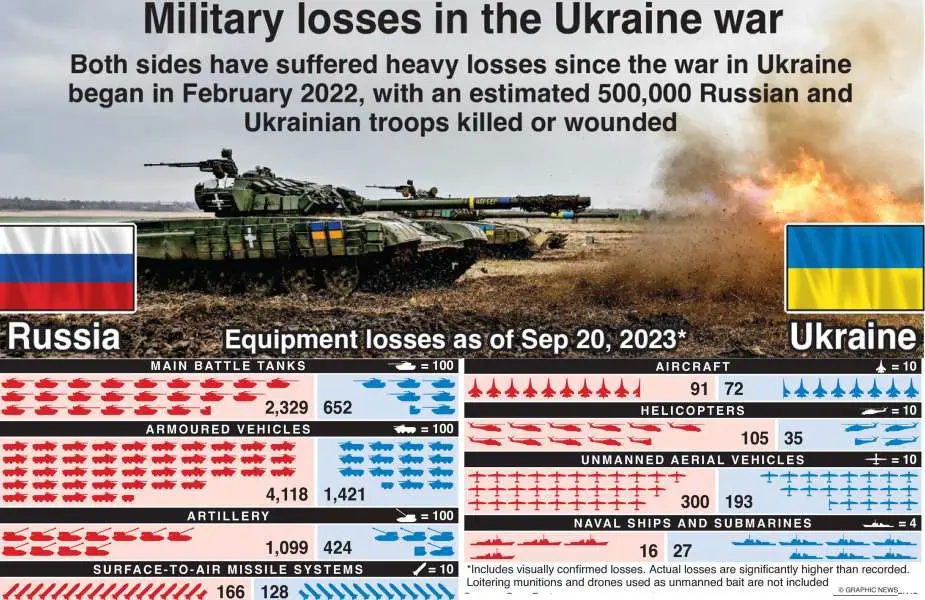Breaking news
Analysis: War's Loss on Russian and Ukrainian Military Equipment and Combat Vehicles since February 2022.
In a comprehensive analysis released by Army Recognition, startling figures shed light on the heavy toll the Russia-Ukraine war has taken on both nations since its inception in February 2022. Drawing from data up to September 2023, the report details the significant losses Russia has endured, both in manpower and military equipment. With the Ukrainian Armed Forces General Staff confirming the loss of nearly 280,000 Russian personnel and a staggering 8,224 combat equipment and vehicles, the scale of the conflict's impact becomes undeniably clear.
Follow Army Recognition on Google News at this link

Graphic of Russian and Ukrainian losses in terms of armored vehicles and military equipment since the beginning of the Russian invasion in February 2022. (Picture source Graphic News that can not be copied or republished)
Before the onset of the war in February 2022, the military capabilities of Russia and Ukraine were notably different, with Russia having a significant advantage in both equipment and personnel.
Russia's long-standing history as a major military power was evident in its vast arsenal and manpower. The country boasted over 15,857 armored fighting vehicles, in contrast to Ukraine's 3,309. In aviation, Russia's dominance was clear with 1,391 aircraft, over ten times Ukraine's 128, and 821 helicopters compared to Ukraine's 55. The naval disparity was also pronounced; Russia operated 49 submarines, while Ukraine had none.
Furthermore, Russia had one of the largest tank fleets in the world, with around 13,000 tanks, more than five times the number Ukraine had, which stood at about 2,500. While Russia had approximately 27,000 armored fighting vehicles, Ukraine had around 8,500. In terms of artillery, Russia possessed around 10,000 pieces, almost four times as many as Ukraine's 2,850. Russia's missile capabilities were vast, including a range of ballistic missiles, cruise missiles, and advanced air-defense systems like the S-400. In contrast, Ukraine had its range of missiles, but they were not as advanced or numerous as Russia's. The Russian Air Force operated around 4,000 aircraft, which was significantly more than Ukraine's 240. Lastly, the Russian Navy, with approximately 360 ships, including submarines and a sole aircraft carrier, dwarfed the Ukrainian Navy, which had a few dozen ships, primarily patrol boats and corvettes.
In terms of manpower, Russia's armed forces were substantially larger with 900,000 active personnel and an additional 2 million in reserve. In comparison, Ukraine had 196,000 active personnel with 900,000 reservists. Specifically, Russia's land forces numbered 280,000 troops, more than double Ukraine's 125,600. The Russian air force was also considerably larger, with 165,000 personnel, dwarfing Ukraine's air force strength of 35,000.
Financially, the defense budgets of the two nations further underscored the disparity. In 2021, Ukraine allocated $4.7 billion to defense, a mere fraction of Russia's substantial defense expenditure of $45.8 billion. Despite these numerical imbalances, the determination and combat will of Ukrainian troops have been highlighted as significant strengths. Analysts have noted the resilience of the Ukrainian forces, with their fighter jets still operational and taking off amidst the conflict, as particularly impressive.
In terms of military strategy, Russia has deployed various systems against Ukraine. Among the most effective is the Ka-52 "Alligator" attack helicopter, which played a pivotal role in operations around Zaporizhzhia Oblast. These helicopters have been responsible for destroying several infantry fighting vehicles and tanks. However, their effectiveness has been curtailed by Ukraine's robust air defense systems. Russia has also strategically placed dense minefields, resulting in Ukraine becoming one of the most heavily mined countries globally. Additionally, Russia has employed "kamikaze" drones, such as the Lancet drone, to target Ukrainian military assets.
Financially, the war has taken a toll on Russia. They have spent more than £134 billion on the conflict, with equipment losses amounting to £27 billion. This massive expenditure encompasses various aspects, including military operations costing £41 billion, servicemen salaries at £28 billion, compensation for the families of the deceased at £21 billion, and assistance to wounded soldiers costing £16 billion. The financial strain has been further exacerbated by the depreciation of the ruble, impacting the overall costs associated with Russian soldiers.
From 24 February 2022 to 29 September 2023, the estimated combat losses of the Russian troops are substantial. They have lost approximately 277,660 military personnel, 2,329 tanks, 4,118 armored vehicles including APCs (Armored Personnel Carriers) and IFVs (Infantry Fighting Vehicles), 1,099 artillery systems including howitzers and rocket launchers, 166 air defense systems, 72 fixed-wing aircraft, 105 helicopters, around 300 UAVs, 16 naval ships and submarines, one submarine, and 930 tactical vehicles and other equipment. These figures are continuously being confirmed and updated. The primary source of this information is the General Staff of the Armed Forces of Ukraine, as they reported on their official Facebook page and were covered by Ukrainska Pravda.
However, as the conflict progressed, the Ukrainian armed forces experienced significant losses. They lost 652 Main Battle Tanks (MBTs), 1,421 Infantry Fighting Vehicles (IFVs), and Armored Personnel Carrier (APC) vehicles. This count includes not only vehicles from the military inventory of the Ukrainian army but also combat vehicles and tanks donated by European allies and the United States. Additionally, Ukraine lost 424 artillery systems, which encompassed self-propelled howitzers, towed guns, and cannons. Their air defense capabilities were hit with the loss of 128 missile systems. The Ukrainian Air Force suffered with the loss of 72 aircraft and 35 helicopters. Furthermore, 193 Unmanned Aerial Systems (UAS) were lost, and their naval capabilities were impacted by the loss of 27 ships.
Note: All this data is based on open-source information.
Defense News October 2023


























